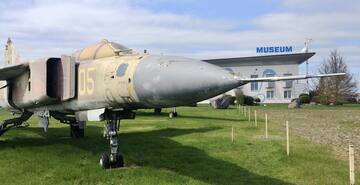Military Heritage Tourism Sites with educational programs
.
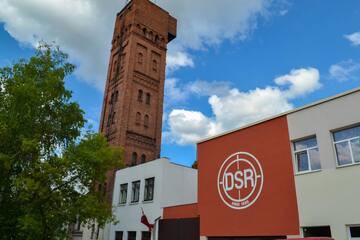
Daugavpils Skrošu factory visit - guided tour
The oldest ammunition factory in Northern Europe (built in 1885) and the only factory of its kind in the Baltics. During the tour, you can see the historical exhibition, the shot casting workshop, climb the unique tower, under which there is a 19-meter-deep cooling well, and visit the shooting range.
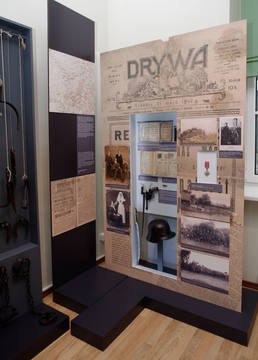
The educational program of the Museum of History and Applied Arts of Preiļi "Thinking about the Holocaust means thinking about yourself"
The lesson takes place in two parts. In the 1st lesson of the program, students visit the exhibition "Museum stories for Latvia" of the Museum of History and Applied Art of Preiļi and learn about the history and culture of the Jewish community of Preiļi. By getting acquainted with the diary of Sheina Gram, a Jewish girl from Preili, which she started writing on the day Nazi Germany invaded the USSR, the students form an emotional connection with the tragic reality of the Holocaust in Preili in the summer of 1941. Lesson 2 is a field trip to the Preilii Holocaust Memorial, during which students learn about the Holocaust tragedy, Jewish saviors, and preserving the memory of the victims in Preilii today. The goals of the program are to strengthen the understanding of the events of World War II and the Holocaust in Latvia, using local history, as well as to promote the development of a tolerant and compassionate personality. Topics related to the subject of history are discussed in the lessons, such as the events of World War II in Latvia, the Holocaust, Nazism, collaborationism.
The program is available in the "School bags" offer.
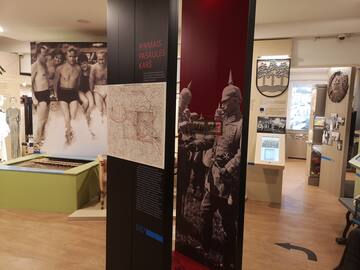
Once in the battles for Latvia
The period after the First World War was a time of turmoil and great change in many parts of the world. Country borders and territories were remeasured, monarchs were overthrown and new countries were created. Latvia was also founded in 1918. How did it happen, where and when? Who were the brave and strong who went to the battlefield and fought for their homeland? How were the defenders of our people and land rewarded for their bravery? The story of the Lāčplēš War Order and the Ogrenians - the knights of this order. The benefit of the lesson is understanding and knowledge of historically important events and people for our country, without whose bravery the country of Latvia would not be what it is today.
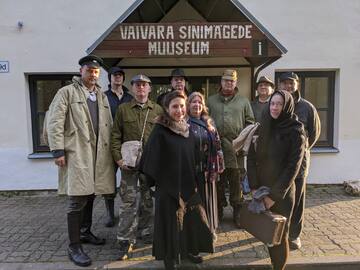
Terrain that influenced military action
The study program consists of 2 main parts:
Hike in the Sinimägedel - provides an overview of the peculiarities of the landscape, the history of its formation, geographical and geological features, vegetation and introduces the places related to II ms.
Practical task – reading maps of different times, positioning and analysis of landscape changes.
Don't touch the bomb!
Children watch the film "Don't touch the bomb", they can see and touch things found in the Blue Mountains. Worksheets/drawing sheets are filled in at the end of the lesson. The program is in cooperation with the rescue agency.
World War II in Estonia
Warring parties of World War II, what was the weaponry, uniforms.
Estonians in the Rifle Corps and German military units, what were the choices and were they voluntary choices.
1944 German retreat battles in Estonian territory, situations in which there were Estonians on both sides of the front.
How is it known and found today who is buried in mass graves.
Introduction of weapons and uniforms, including the armament of which army the weapon was a part of and what were the characteristic distinguishing marks of the armies.
Excursion to Põrguaugumäe (memorial to those who fell in World War II) and Parkimäe (the Vaivara manor was located on the mountain and there are bunkers from World War I).
Watching the movie "1944" if desired.
A war game
Students receive mobilization invitations. In the course of the program, you will learn how an Estonian got into the army and what uniforms he wore; what were the weapons that were used at the time. Living conditions during the war, including the distribution of food stamps.
Organizing an air alarm, the subject of the March bombing of Narva.
Providing first aid.
How trenches were dug and when they are useful.
Excursion to Pargimäe (the Vaivara manor was located on the hill, there are bunkers from the First World War).
Watching the movie "1944" if desired.
Time travel 1944
The Vaivara Sinimägede Museum invites you to take part in a time travel, where the 1944 escape from the Narva region is relived. Before the adventure takes place, the participants are sent a scenario via e-mail, which describes the evacuation and offers roles according to the participants. This gives you the opportunity to make choices about what to take with you, what to wear and what the menu for the picnic at the end of the trip could be. Also, the pre-sent scenario helps to give the participants some hints to observe certain details during the adventure, so that the journey is as real as possible. But creativity is also always welcome and often makes the adventure even more memorable and enjoyable.
Time travel is suitable for both adult groups of friends and families with children. It is very different from other similar adventures and provides a good opportunity to discuss modern refugee issues later.
In such an undertaking, it is not possible for each journey to proceed in the same way as all the previous ones. The adventurers themselves play a very important role in this adventure. It all depends on the participants. Therefore, the adventure is completely unique and creates new emotions for everyone, including those who have already gone through it before.
The instructors conducting the time travel are specialists in their field who have carefully thought out the entire scenario. So you can be sure that the service you experience will be first class.
Pre-booking is required to consume the adventure, and the journey begins at the Vaivara Sinimägede Museum.
Stories of things
During the program, students will learn about the stories of the museum's exhibits: what and what the soldiers ate, where the documents were kept, what the soldiers' uniform should be and what they carried. You can touch and try the exhibits (helmets, hats, weapons). They talk about why we keep things in a museum.
Terrain game
During the program, students learn how to read a map, what the symbols and colors on the map mean. Using the map, students find checkpoints and solve the corresponding tasks. The terrain game goes through the most interesting places of Sinimäe settlement, such as Sinimäe elementary school, World War I bunkers and Pargimägi. A visit to the museum will also take place during the game.
The museum is coming to visit. Military uniforms and weaponry
Students will learn about the Second World War on the territory of Estonia. Get acquainted with the uniforms and weapons of the German and Soviet armies. If desired, there is an opportunity to try on clothes.
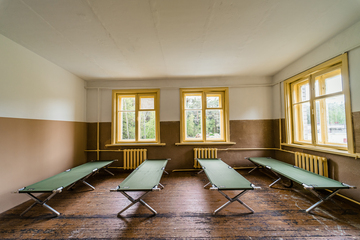
Survival School
Study tours in nature FOR STUDENTS: If your child's class also wants to spend a quality day in nature, to:
👉 improve mutual communication, trust and cooperation;
👉 spend time together in nature without a phone (digital detox);
👉 learn useful survival skills in order to be able to take care of your health and the lives of people around you in crisis situations,
then call the SCHOOL OF SURVIVAL ☎️ 26442462 and request a student excursion.
☘️ The students of Riga and Pieriga go to Baldoni
☘️ Liepāja, Ventspils, Kuldīga students to Pāvilost, where the SURVIVAL SCHOOL training and camp center is located.
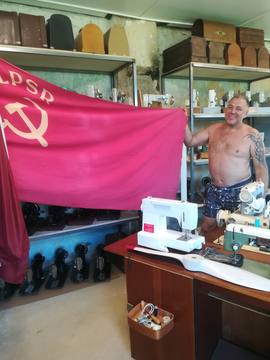
Private collection of 200 sewing machines
A place where it is possible to view more than 200 different working sewing machines from different countries, starting from the pre-war years to the late Soviet era products.
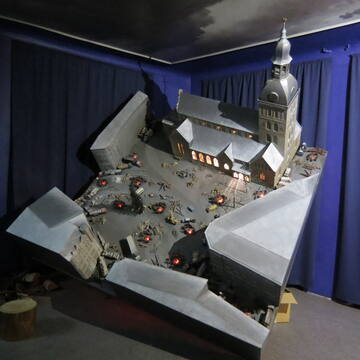
CV of barricades
Students are offered various activities in the halls of the museum. In the first hall, students can get an idea of life in the USSR, about the Revival, see posters on social topics. In the second hall, students watch the film "The time of our barricades", discuss the strategically important, protected objects. In the third hall, "With courage against troops", students learn about the two opposing forces, the People's Front and the Interfront, other Latvian cities, which were also very important points in the barricades, as well as you can view the model of the Council of Ministers and on the touch-sensitive screens you can view photo and video materials from the 1991 collection of the barricade museum. In the hall dedicated to the January 20 shooting, students have the opportunity to watch a specially created animated film, where the January 20 attack on the Ministry of the Interior has been reconstructed. In the "Echo of Barricades in the World" hall, you can see a car from the time of the barricades and a satellite dish that transmitted information about the barricades to other countries. After viewing the exhibition, students are given worksheets. In order to fill them in, the students must remember what the tour guide told them, and independently look for clues and answers to questions in the exposition.
To the barricades
Students are offered various activities in the halls of the museum and in Riga, at the barricades. In the first hall, students can get an idea of life in the USSR, about the Revival, see posters on social topics. In the second hall In the second hall, students watch the film "Time of our barricades", discuss the strategically important protected objects. In the third hall, "With spirit against troops", students learn about the two opposing forces, the People's Front and the Interfront, other Latvian cities that were also very important points in the barricades, as well as they can see the model of the Council of Ministers and on the touch-sensitive screens they can view photo and video materials from the 1991 barricades museum collection. In the hall dedicated to the January 20 shooting, students have the opportunity to watch a specially created animated film, where the January 20 attack on the Ministry of the Interior has been reconstructed. In the hall "Echo of barricades in the world" there is an opportunity to see a car from the time of the barricades and a satellite dish that transmitted information about the barricades to other countries. The students are given the task to divide into three teams and the excursion leader determines the task of each team. Later, accompanied by a guide, the students visit the main barricade sites in Old Riga, which they have heard about before - Dom Square, the Saeima House and the memorial plaque of the barricades placed next to it, Bastejkalni and the former Ministry of the Interior building, the Freedom Monument, the 11 November embankment and Kaļķu Street - as the only entry way into Old Riga in January 1991.
Let's play barricades
Students are offered various activities in the halls of the museum. In the first hall, students can get an idea of life in the USSR, about the Revival, see posters on social topics. In the second hall, students put on three characters of the time of the barricades, dressing up one of the group members as a barricade defender, a member of the militia of the Republic of Latvia or an OMON fighter, choosing suitable items from the props boxes. In the third hall, students place models of equipment on specially designed city maps in those city objects that they think need to be defended today and that were defended in 1991. In the hall dedicated to the January 20 shooting, students have the opportunity to watch a specially created animated film, where the January 20 attack on the Ministry of the Interior has been reconstructed. In the "Echo of Barricades in the World" hall, you can see a car from the time of the barricades and a satellite dish that transmitted information about the barricades to other countries. The students are given a task to divide into three teams and the leader of the excursion determines the task of each team - to prepare a short message about one of the events of the barricades, which will be broadcast 1) on the radio 2) on TV or covered in the press.
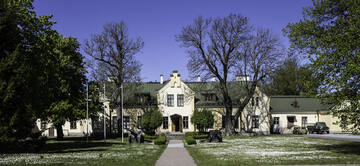
Military paterns
Patterns are part of warfare. Already ancient warriors covered their faces and bodies with war paintings, which instilled in them strength and bravery. Today, a camouflage pattern uniform helps the modern-day soldier hide from the enemy. Military parade uniforms and weapons have beautiful patterns to emphasize solemnity, etc. During this game, players search for patterns and shapes in the war museum exposition. They can be found everywhere - on maps, walls, weapons, uniform cubes. The players are formed into teams of 3-4 members and must go through all the expositions of the museum. After answering the last question, you return to the starting point of the game, after which the correct answers are reviewed and discussed with the game leader.
Workshop about the history of the sword
In the workshop we will talk about swords, from what the first swords were made of, what carrying a sword meant for a warrior in the past and what it means today. Children can explore which swords are found in the war museum and learn what parts a sword is made of. During the workshop, children make paper swords, decorating them according to their imagination.
Discovering war museum with Jänku-Juss
Tour around the museum for small children.
Badge making workshop
Since ancient times, warriors have earned honor and fame for their bravery and cleverness, and have received orders for their heroism. In this workshop, together with the children, we will see which orders are found in the war museum and briefly introduce the history of orders. In the end, everyone crafts a gorgeous order.
Estonia and Cold War. Role play
The educational program deals with the situation in Estonia after World War II until the end of the Cold War when the USSR collapsed. In the workshop students find out how resistance took place in Estonia after the end of World War II. We will discuss whether and how, despite the occupation and repression, the Soviet military bases located on the territory of Estonia, and the suppression of independence efforts, the dream of a free country lived on in people and the re-independence of Estonia became possible. The program takes place in the form of a situational game, where the task of the participants is to choose a character and analyze his choices and opportunities to stand up for Estonia's freedom during the Cold War period, both here and beyond the "Iron Curtain".
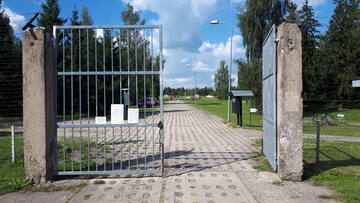
Educational program "Games and discoveries at the rocket base"
Do you like history, are you interested in the Cold War period? Want an unconventional museum lesson? We offer such an opportunity at the Cold War exhibition. During the educational program, it will be possible to get acquainted with the historical period of the Cold War and the only operational underground missile launch base in Lithuania. During the education, the participants, divided into groups, perform a variety of tasks promoting active cognition: deciphering a coded secret combat signal, learning to properly put on a gas mask, and getting to know the environment through the senses (hearing, sight, smell and touch).
This education is a game full of interesting stories, tasks, new missions.
The program is intended for students in grades 6-7,
Group size: up to 30 people.
Excursion "Cold War Exposition in a different way"
Arm yourself with flashlights and get ready to get dirty! You will be given the opportunity to explore the most secret corners of the underground missile launch base and learn the history of this special facility. And where else is the opportunity to spend an hour in a space completely isolated from the outside world! There is no mobile connection, no internet, and the only source of light is a handheld flashlight. The body of those who got here shivers, and when listening to the stories and facts that happened here, the visitor feels a threat to all humanity...
Organized groups: with advance registration of adult groups, up to 30 participants.
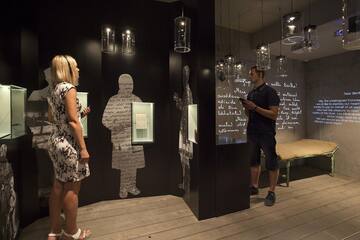
20th century historical sites in the Old Town
The Old Town hides centuries of history. While we mostly know the Old Town through its medieval and modern buildings and structures, the orienteering game “20th Century Historical Sites in the Old Town” found on the online environment avastusrada.ee leads players to the trails of recent history, to the years 1918–2010. It includes ten historical buildings and sites with questions that require attention and exciting additional information. Buildings related to Estonia's darker history, sites related to the restoration of independence, as well as important buildings from cultural history are waiting to be discovered.
The many facets of collaborationism
George Orwell's novel "1984" paints a picture of a totalitarian society where everyone betrays everyone else. How does a foreign power establish itself in an occupied area and how does power begin to shape our thoughts and actions? Why do some go along with the foreign power, while others stick to their beliefs and resist? In the museum lesson, we will explore stories of collaborationism during both the German and Soviet occupations. Through active learning methods, we will discuss the causes and consequences of collaborationism on both a societal and personal level. Finding points of reference in the discussion also from Orwell's famous novel.
Don't want to go, but can't stay
In 1944, nearly 80,000 people fled Estonia, fearing a repeat of the horrors of the first year of occupation. Who were those who decided to go? Why did they go? What did they feel? What did they risk when fleeing and what awaited them in their new place of residence? What were the difficulties of adaptation in a new country? How did they keep their culture alive abroad? These are the questions to which the museum class seeks answers. The class helps to understand the main challenges of refugees and to better understand them.
2 stories, 2 places – a journey of the mind into history
The museum lesson “2 stories, 2 places – a journey of the senses into history” is primarily intended for students with special mental and learning disabilities, with whom we discuss what history is and why we study history. To better understand Estonia’s recent history, we will take a time journey to 1941 and 1944, where we will talk about deportation and the Great Escape through the story of 14-year-old Hans and Urve. We will use our senses of sight, hearing, touch and smell to illustrate the stories. On the journey, we will discover what Hans packed with him for deportation and what his home looked like far away in Siberia. Using emotion maps, we will discuss how Urve might have felt when she had to undertake an escape journey to the free world and what trials awaited her on the journey and in her new place of residence. At the end of the lesson, we will reflect on whether and what similarities there are in the stories of Hans and Urve compared to the stories of today's youth, both in Estonia and elsewhere.
The magic of historical research
Why is studying the past so important to us? How do we obtain information from historical sources whose background is unknown to us? What is the difference between studying oral, written, visual and material historical sources? What does source criticism mean? The museum lesson is suitable for young people starting to study history and who want to better understand the work of a historian. We will study sources in the museum's collections that deal with the darker side of Estonia's recent history - the German and Soviet occupation, deportations, the Holocaust, as well as material historical sources concerning everyday life. By the end of the lesson, students will have a self-compiled guide for historians to study the past.
In the whirlwind of war – coping with difficulties
The virtual time travel VR Tallinn 1939/44 first takes you back to before World War II and introduces the history of Tallinn's Harju Street. Through VR glasses, you can spatially, colorfully and interactively experience how beautiful Tallinn was before World War II. An audio guide compiled by historians introduces the history of Tallinn's buildings, businesses and cafes. The second part of the virtual journey takes you back to the time of the German occupation, which includes the Soviet air force's attack on Tallinn and the consequences of the March bombing of Harju Street in 1944-1946. The program continues in Vabamu and explores through biographies what a person's life could and can be like in the midst of war and under harsh policies. Why did many people decide to leave their homeland? Who stayed and will stay? Who was forcibly taken away? What choices did young people have to make in the past and what choices do they have to make today? We also make easier or harder choices in our own lives every day, which can permanently affect our fate. But what about our ancestors? What was their fate? What were or were not their choices? The joint program provides a good overview of the fate of Tallinn in World War II and teaches us to understand the choices of people in the midst of war, who cope with difficulties despite everything.
Different forms of resistance
In the museum lesson, we will discuss different forms of resistance during the Soviet occupation through personal stories, creating parallels with today's unfree societies. We will talk about Otto Tief's government, student resistance, the Forest Brothers, dissidents, foreign struggle, and the Singing Revolution. Using source analysis, we will seek answers to several questions. What motivated young people to remain true to their values, while risking a prison camp? What choices did the Forest Brothers' helpers face? What role did underground literature play in the resistance?
On the path to restoring independence
The orienteering game “On the Paths of Restoring Independence” takes players back to the time of the Singing Revolution, 1987–1991. The Singing Revolution is a collective name for the mass nationalist demonstrations that preceded the restoration of independence in Estonia, where the singing of patriotic songs played an important role. The game features 13 historical buildings and places, along with tasks that require attention, discussion, and movement, as well as exciting additional information. Depending on the form of the question, you will only get to the additional information after saving your answer. If the places are marked chronologically on the map, you can safely pass through points located close together in a row.
The role of civil society in protecting freedom
The support of the Estonian people for Ukraine has been great since the war broke out in 2022: whether it is expressed in demonstrations, donated money and things, volunteer work or in other ways. In the museum lesson, we will explore how a strong civil society is the foundation of a free state and whether and how Estonian civil society has changed while helping Ukraine. We will also discuss humanitarian aid and development cooperation in a broader sense. The lesson will focus on participatory discussions and case studies.
Freedom as our greatest treasure
The lesson is intended for students in grades 7-12 and deals with the topic of war and peace, telling stories about the choices made by Estonians during World War II and the occupations that followed. In this value-based and active learning-focused museum lesson, we will explore, through World War II and biographies, what a person’s life could and can be like in the midst of war and under harsh politics. What are people willing to risk to stand up for their homeland, loved ones, and freedoms, and what can these choices bring? We will analyze the political situation and choices in Estonia before and after World War II in more detail. We will also talk about resistance, escape, and going to the front against foreign power based on the biographies of five different people. In addition, we will discuss what each of us can do to preserve and value our hard-won national independence and the freedoms that come with democracy.
Freedom and equality as a right and a duty
We all have rights, but we often tend to forget that rights also come with responsibilities. What fundamental human rights are listed in the Convention on the Rights of the Child? In the museum lesson, we will reflect on the topic of equality, freedom and human dignity, both in history and in modern Estonia, using real-life stories. To enliven the discussion, we will try to step into the shoes of real people, whether the wearer of these shoes is Hans, who grew up in Siberia, or Urve, who fled to Sweden. By the end of the lesson, a class declaration of rights and responsibilities will be completed so that we can continue to remember: rights and freedoms can only be maintained if we fulfill our responsibilities.
Toys tell stories
Were there games, toys, children's shows or films before Angry Birds, tablets, Monster dolls and Jänku Juss cartoons? Rumors are circulating that there were. In the museum lesson, we will get to know the toys, games and children's shows that were familiar to our grandparents who lived in the Estonian SSR. We will examine the model cars that drove along the living room parquet floor when the Beatles were doing great things in the world. We will hear stories about the toys that brought joy to Estonian boys and girls who fled to the West during World War II and to children from families deported to Siberia. Through creative activities, students become little historians who give their own interpretation to historical objects.
What is freedom?
The focus of the museum lesson is the discussion “What is freedom?”. What could freedom have meant for grandmothers and grandfathers? What could freedom have meant for those children who had to escape by boat across the stormy sea? What was freedom for those who were sent far away to Siberia and who grew up without parents? Is having few toys a restriction of freedom? We will try to find answers to many contemporary questions through children's life stories. Why is it important to support and help each other? Do you have to live at home to be free? Do you have to fight for freedom? Can everyone be free? Can you be happy when you are not free? We will discuss these and many other questions. To make the discussion memorable, each child will create their own personal freedom compass.
Where does humanity end?
The museum lesson offers an opportunity to visit the infamous prison cells on Pagari Street and reflect together on why it is important to remember and commemorate. We will discuss crimes against humanity and think about what makes a person collaborate with a totalitarian regime and destroy fellow citizens. In small groups, we will explore the history of the house and the KGB. We will hear thought-provoking stories about the background of political terror and the possibilities of resistance. We will get to know the memories of people who were prisoners in the Pagari house and who came out of it alive. We will explore the feelings and thoughts of a person in a hopeless situation and what helped them survive this difficult period of their lives. At the end of the lesson, we will discuss how such stories help us to improve tomorrow and what each of us can do to prevent the crimes of the past from being repeated. Pre- or post-activity: we recommend viewing the videos about fear and repression in the learning environment “History on Screen”.
The impact of war on the individual
In the museum lesson, we will explore through life stories what a person's life could and can be like in the midst of war and under harsh policies. Why did many people decide to leave their homeland? Who stayed and will stay? Who was forcibly taken away? What choices did young people have to make in the past and what choices do we have to make today? We also make easier or harder choices in our own lives every day that can permanently affect our life destiny. But what about our ancestors? What was their life destiny? What were or were not their choices? In the museum lesson, we will look back at the escape and repression during the German and Soviet occupation. In groups, we will explore what could have influenced the decisions made by Olaf, Linda, Magda and many others and how the choices they made influenced their future lives.
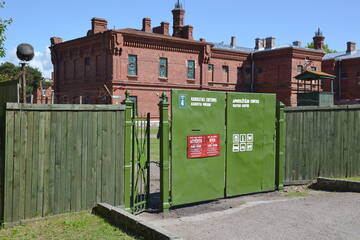
The spy game "Escape from the USSR"
The idea of the game is to give the participants the opportunity to actively participate - to think, search, run, hide, make decisions, help friends, enjoy feelings that are not easy to find in today's organized everyday life. The game takes place in the Northern Forts - underground and above ground.
Tour of Karosta prison
During the tour, you will have the opportunity to see the prison, which has hardly changed since the time of the tsar, to learn about the history of Karosta and interesting events from the life of the prison, to see the cells and cells, as well as to get to know the expositions of the Karosta prison museum, which tells about World War II, the Kurelians, the Soviet times.
The show "Behind bars"
"Behind Bars" is a historical reality show with audience participation. It is based on true stories from the life of the Karosta warden. The essence and purpose of the performance is to allow each participant to assume the role of a prisoner and get acquainted with the most interesting and shocking facts from the history of the prison.
Tour with elements of the show
An excursion with elements of the show is an event for those who want something more than an ordinary excursion and who are afraid to participate in the show "Behind Bars"! During the tour, you must observe discipline, you must participate in the training of the rank and file, you may be placed in a cell, but in case of disobedience you will be punished.
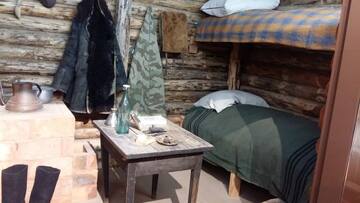
“History through human destinies”; "Metsavend Alfred Käärmann and the choices of the 1940s"
Alfred Käärmanni (1922–2010), the legendary Võruma forester, went to the forest as a young man after the start of the second Soviet occupation in the fall of 1944. A year later, he was wounded in the left hand by an explosive bullet in a raid and escaped with his life thanks to Latvian forest brothers who organized medical assistance. Alfred lost his left arm. Despite this, he managed to resist for another seven years, and only with a poisoned drink offered by a traitor who became an MGB agent, the forest brother was caught alive. He was sentenced to twenty-five years of forced labor, to this utopian sentence was added another five years of being sent to a settlement. Alfred was able to return to occupied Estonia in 1981, his persecution only stopped during the years of the singing revolution.
At the initiative of Alfred Käärmann, the principle written in the preamble of the Constitution of the Republic of Estonia is that the Estonian state and its constitution must ensure the preservation of the Estonian nation and culture throughout the ages.
Alfred Käärmann was one of the most active men in the restoration of independence in Võrumaa: he helped to re-establish the Defense League and was elected a representative of the Estonian Congress. He has published books, the most well-known of which are Against the Deadly Enemy (2000) and The Spirit of Freedom (2000). He has been awarded the medal of the Kotkarist IV class.
We all have to make choices in life, some more important than others. The point of studying history is to develop judgment. History provides an opportunity to look at the results of decisions made by predecessors. In the museum class, we reflect on the choices that Võrumaa's youth had in the 1940s. To immerse ourselves in the era, we try to step into the shoes of several real people, be it Alfred who went to the forest, Karl who escaped to Sweden or Aleksander who stayed at home. We think about what their choices were and what we would do in their place. The distance of 80 years from these events gives us the opportunity to know what the consequences of these choices were.
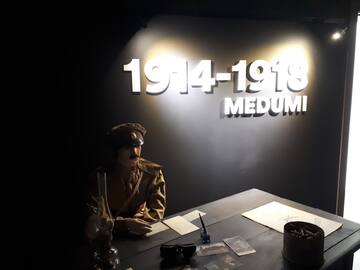
Future Soldier Breakout Game
The lesson offers students the opportunity to gain a deeper understanding of the events of the First World War and the everyday life of its participants. Students are offered various activities - studying documents, front-line reports, photographs, actively participating and talking with museum specialists, program participants learn about the types of weapons used in the First World War, the ammunition of the Russian and German armies. Participants are offered the opportunity to decipher the “Morse Code” system message, listen to soldiers' songs, walk through the imitation of the Russian army trenches and immerse themselves in the atmosphere of the front line, as well as write a letter to themselves from the front line.
Traces of the First World War in the Augšdaugava region
The lesson will allow you to look into the history of the early 20th century, study and experience the events of World War I and the everyday life of its participants.
The First World War is most often associated with the involvement of all the great powers in hostilities, with thousands of kilometers of trench systems, the Western and Eastern Fronts, with the flow of 500 thousand refugees, with the use of poison gas, however, this is only part of the events of the war. No less extensive hostilities took place here in the territory of the Augšdaugava region. The war, which changed the landscape of the region beyond recognition, lasted almost three years near Dvinsk (Daugavpils). Although more than 100 years have passed since these events, the echoes of the war - trenches, bunkers, ammunition - can still be found.
During the lesson, using archival documents and artifacts, there will be an opportunity to find out how the war entered this area, which determined the location of the positions of the warring parties, the characteristics of the battles, creating an understanding of the course of hostilities. Visitors will have the opportunity not only to gain theoretical knowledge about the war, but also to work interactively, restore the events of that time, walk through the trenches of the Russian army (an imitation of which is located in the museum itself), feel the atmosphere of the front line, and draw conclusions about the meaning of war in the modern world.

Life on Saaremaa after World War II
In the lesson, we travel back in time to the recent past and talk about life on Saaremaa during the Estonian Soviet Socialist Republic. The experience in the lesson allows students to discover the diversity of that time and understand the conditions in which their grandparents lived, worked, and studied. Students have the opportunity to compare their choices and opportunities with those that were available at that time.
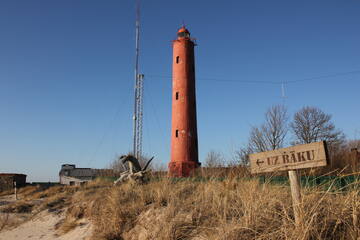
Excursion to Akmenrag lighthouse
It is possible to climb the Akmeņraga lighthouse via a spiral staircase. Climbing the lighthouse offers a fantastic view of the sea and surrounding forests. The lighthouse is the main ornament of Akmeņraga. In 2011, during the implementation of the project, the road to the Akmeņraga lighthouse was reconstructed. Far beyond the borders of Akmeņraga, information has spread about the unique collection of amber and stones collected by the lighthouse keeper.
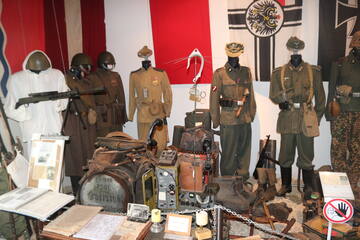
WW2 World War Exposition
Groups can be guided by a guide who knows the history of each subject and its use. The relatively small space contains 1000+ exhibits, which are skillfully arranged and are easy for visitors to view without having to walk long ways and many floors. The core of the museum is the weapons of the 2nd world war conflict. Also on display are uniforms, ammunition, household items, aircraft wreckage, etc. The most precious and unique is the feldpost (field) letter correspondence between Oberlieutenant August and his beloved Marta during the five years of the war. Dialogue in letters between two people who love each other with a happy ending. In the background you can see the chronicle of those times. The expedition is not politicized, but divides the two warring parties equally. There is neither good nor bad here, maybe that's why it's easy to watch and visitors like it.
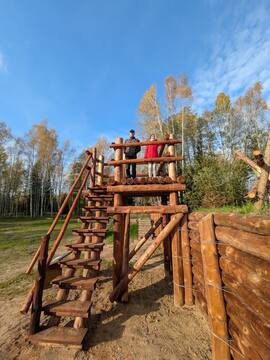
Latvian archer in Christmas battles
In the Christmas Battle Museum - an authentic battlefield of World War I, we will create an idea for young people about the role of a person in war conditions, the daily life of soldiers and participation in battles. With an insight into military discipline and various interactive tasks focused on team building, we will create emotions that will make you think. After the lesson, you can use the bonfire site and a 7 km long informative walking trail through the battlefields on the territory of the museum.
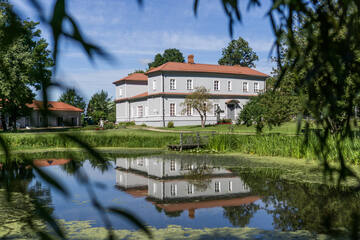
Exhibition "Ludza Region 1918 - 1945"
The exhibition reflects an important historical stage in the development of Eastern Latgale from 1918 to 1945. The exhibition features various relics from this historical era.
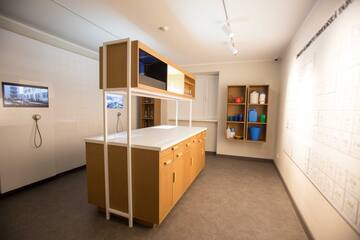
Touch the past. Understand today
The purpose of the program is to encourage students to be interested in the past, its events, and to look for connections with the present. Watch 5 short films together about life and everyday life in Latvia in the 20th century. in the second half. Let's get acquainted with the items sent in the "time capsule", their origin, manufacturer... while also learning how and where to look for the manufacturer. And then, through tasks and games, evaluate and compare those times with today. This program is not about the war, but it is definitely related to the consequences of the war on the everyday life and economy of the people of Latvia.
Time travel. 1919
The purpose of the program is to promote awareness of Lāčplēš Day and to strengthen the national identity of the new generation. In this lesson, the students have the opportunity to travel to the year 1919, dividing into teams, the students will assume the roles of two opponents - the Latvian army and Bermont's troops. Using the appropriate equipment, they will perform various tasks, create defensive positions, go scouting, and create hideouts in order to find out the historical winner at the end of the lesson. A circular walking path has been created along the route, which includes an armory, a dugout, an artillery point, and a cannon. All mentioned points of interest are located where evidence of their location has been found in archaeological excavations. This route also includes a memorial stone for those who died in the freedom struggle and a model of the soldiers' settlement as it was during the First World War. There are signs along the entire trail with Braille signs and everything is accessible to people in wheelchairs, so people can explore and enjoy the place as well.
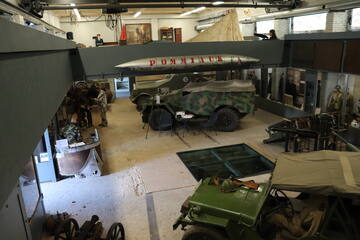
Estonian War of Independence
Lecure + museum visit.
Preparing military food of the WW2
Short lecture + making solder food in outdoor military kitchen.
"Watch out, bomb"
Professional deminiers lecture, workshop
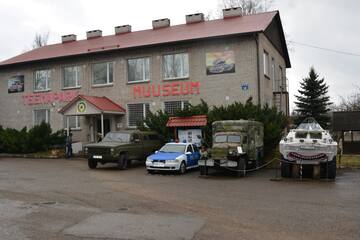
Shooting simulator
The safe shooting simulator offers an opportunity to practice both for young people interested in shooting sports and for grandparents with a military interest. The target displayed on the screen shows shooting results and helps to improve performance.
Museum tour with a guide
Guided tour through the Valga War Museum gives a great overview of Estonian history from the 20th century. Museum offers an introduction into the history of Estonian civil services and national defence agencies. Tour is curated according to the age group.
Defense line "Walk" outdoor program-lecture
Defense line "Walk" lecture on the Sooru plateau or the Paju battlefield
Estonian military history (War of Independence, forest brotherhood, regaining independence, etc.)
Various ventures on Estonian military heritage: World War I in Estonia, War of Independence, forest brotherhood, regaining independence, etc.
There will be a lecture and an introduction to the museum exhibition.
Laser battle
Laser battle is a fun social competition between teams. We offer battles both on the museum grounds and in the trench complex and in a converted USSR-era barn. Laser battles are not only intended for children, but are also well suited for corporate events or team training. Laser games develop reaction speed, decision-making and cooperation. Players get a good physical workout as well as a memorable gaming experience.
You can choose between three battle sites: the military museum's courtyard, the trenches on the Sooru hill, or the building on the Reku training area. In case of rainy weather, outdoor games will not take place.
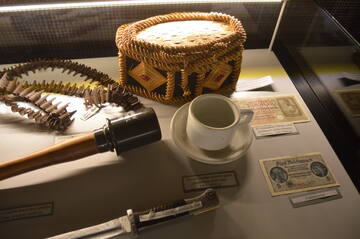
Museum educational program-excursion "We create history ourselves"
The Viļaka Museum offers pupils and students a unique excursion-museum pedagogical program to the national partisan settlement in Stompaki. During the excursion, we get to know the activities of the national partisans in Northern Latgale, see the restored bunkers and participate in various tasks. We learn to encrypt text, get to know the areas of activity of the national partisans (camp, saboteur group, supporters, attitude at different times, the Battle of Stompaki and the composition of the warriors of the Battle of Stompaki), subscribe to a special magazine with your own invented nickname, search for lost texts).
Excursion for students "Traces of War in the City of Viļaka"
A city tour, during which we explore places related to World War II, visit the military section of the Viļaka Museum exposition, the Viļaka Catholic Church and the nearby national partisan memorial site, as well as visit the Jewish Holocaust memorial site.
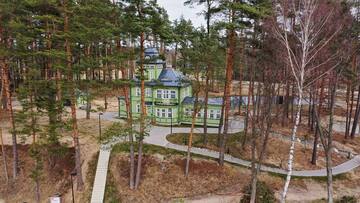
A Walk in the Northern Camp
In 1926, on the initiative of General Nikolai Reek, the Pechory Northern Camp of the Defense Forces of the Republic of Estonia was established on the shores of Lake Õrsava in Värska. It was the summer training center of the defense forces, where cavalry and artillerymen from all over Estonia practiced. Soldiers' barracks, staff building, residences for officers' families, the camp chief and commandant, a bakery, stables for horses, a shop, a 500-seat casino and a canteen, and other auxiliary buildings were built by the soldiers themselves. The arrival of the soldiers in the spring significantly enlivens the life of the region. Most of the buildings have been destroyed by now, but the barracks that housed the soldiers and some residential buildings have survived. In 2020, the summer residence of General Nikolai Reek, which was part of the complex of camp buildings, was opened in a restored form, which is a fine example of the Art Nouveau style loved in the 1920s. On a walk in Northern Camp, we revive the former camp life with the help of old photos and stories.
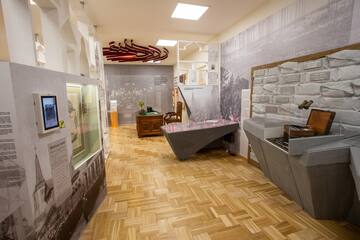
"Valka - Cradle of Latvian Independence" educational program
The story of social and political events in Valka from 1914 to 1920.

The history of the establishment and protection of the borders of Ludza region. Testimonies from World War II and the Soviet era
A review of the collection of testimonies from World War II and the Soviet era with a story. A digital exhibition about the border of Ludza region, the activities and life of border guards starting in 1920.
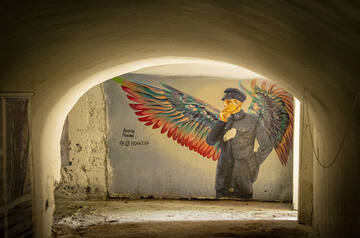
Mystery Island REDAN
Mystery island REDANS – a fun game for groups with staging a play, orientation, ingenuity and dexterity tasks, learning new knowledge.
Redans
Redan is part of the tsarist fortress built at the end of the 19th century, where fierce battles took place in 1919 defending Liepāja against Bermont's troops. Now in Redana it is possible to get acquainted with the history of Karosta, Liepaja fortress and the heroic defense of Liepaja in 1919.
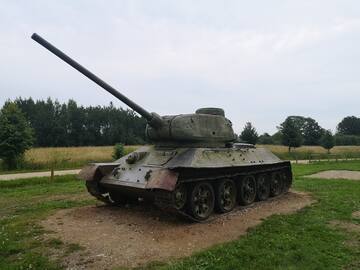
Memorials of the Battle of the Sea of the Second World War
The Museum of Sea Battles features a well-organized open-air exhibition of military equipment, with the Red Army tank T-34 as its most prominent attraction. The indoor exposition is dedicated to the memory of the battles of More and their historically significant turning points during World War II and the events of World War I in More parish, and the battles for freedom in Latvia. Various local history exhibitions, 19th century. and 20th century household and craft items. Exhibitions of regional artisans and a wide selection of original souvenirs. In the museum, you can get the booklet "Memorial sites of the Mores Battles", which contains a brief description of the history and places of interest and other necessary information to independently visit the nearby Mores Battles Memorial Park with buildings of the ancient front line and the graves of the fallen soldiers' Brothers in Mores Parish.
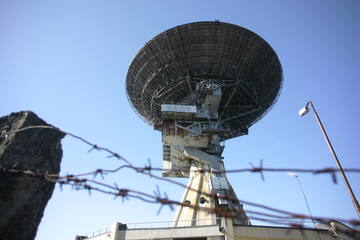
Tour of the Irbene radio telescope complex
During the tour, visitors have the opportunity to see the RT-8 tower and the expositions located in it about the operation of RT-32 and RT-16 during the USSR, which at that time operated as a space intelligence station. Excursionists will have the opportunity to see the "old" RT-16 antenna, as well as the rest of the territory, as well as a hike through the underground tunnel.
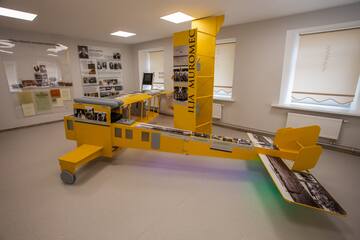
To think about the Holocaust is to think about yourself
The lesson takes place in two parts. In the 1st lesson of the program, students visit the exhibition "Museum stories for Latvia" of the Museum of History and Applied Art of Preiļi and learn about the history and culture of the Jewish community of Preiļi. By getting acquainted with the diary of Sheina Gram, a Jewish girl from Preili, which she started writing on the day Nazi Germany invaded the USSR, the students form an emotional connection with the tragic reality of the Holocaust in Preili in the summer of 1941. Lesson 2 is a field trip to the Preilii Holocaust Memorial, during which students learn about the Holocaust tragedy, Jewish saviors, and preserving the memory of the victims in Preilii today.
The goals of the program are to strengthen the understanding of the events of World War II and the Holocaust in Latvia, using local history, as well as to promote the development of a tolerant and compassionate personality.
Topics related to the subject of history are discussed in the lessons, such as the events of World War II in Latvia, the Holocaust, Nazism, collaborationism.
Exhibition at Preili 1st Primary School "Jāzeps Baško - Airline Driver"
The exhibition “Jāzeps Baško – Air Driver” was created in 2014 and is dedicated to the 125th birthday of the outstanding countryman, aviator, commander of the “Iļja Muromec” squadron, organizer of the Latvian Air Force, General Jāzeps Baško and the 100th anniversary of World War I. The exhibition of the museum’s collection is designed as a design object – a 6-fold reduced model of the “Iļja Muromec” aircraft, on which information can be found in the form of text and images. The exhibition is enriched by deposits from the collections of the Latvian War Museum and newly acquired information from the Latvian State Historical Archives, the Spilve Aviation Museum and materials from the private archives of individual individuals.
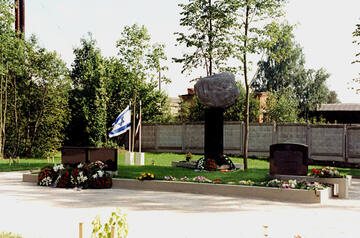
The educational program of the Museum of History and Applied Arts of Preiļi "Thinking about the Holocaust means thinking about yourself"
The lesson takes place in two parts. In the 1st lesson of the program, students visit the exhibition "Museum stories for Latvia" of the Museum of History and Applied Art of Preiļi and learn about the history and culture of the Jewish community of Preiļi. By getting acquainted with the diary of Sheina Gram, a Jewish girl from Preili, which she started writing on the day Nazi Germany invaded the USSR, the students form an emotional connection with the tragic reality of the Holocaust in Preili in the summer of 1941. Lesson 2 is a field trip to the Preilii Holocaust Memorial, during which students learn about the Holocaust tragedy, Jewish saviors, and preserving the memory of the victims in Preilii today. The goals of the program are to strengthen the understanding of the events of the Second World War and the Holocaust in Latvia, using local history, as well as to promote the development of a tolerant and compassionate personality. Topics related to the subject of history are discussed in the lessons, such as the events of World War II in Latvia, the Holocaust, Nazism, collaborationism.
The program is available in the "School bags" offer.
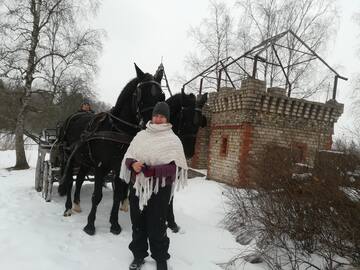
Horse riding in "Stiebrin"
We offer riding with horses and ponies, we provide sharp sensations in a racing carriage. We offer exciting and educational tours for groups. During the tour, you will learn various interesting stories from pre-war times and see the consequences of war devastation, which can still be seen today in the "Stiebriņi neighborhood".
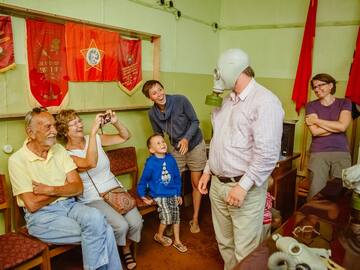
Object X
A game for active people who are not afraid to go on a secret mission - in the dark, under the cover of smoke through the labyrinths of the underground corridor. The purpose of the reality game "Object X" is to allow participants to assume the roles of secret agents and complete a secret mission in an authentic environment.
Soviet secret bunker offer for school groups
Experience the atmosphere of the Soviet era and learn more about the history of Latvia by visiting the secret bunker of the Soviet era, built for the leaders of the country in preparation for nuclear war. The bunker impresses with its authentic attributes and fascinating historical stories.
Excursion to the exhibition "Cultural History of Daugavpils Region"
Visitors are offered a journey into the past and an insight into the history of the region starting from the 9th century BC. It also focuses on the events of the First World War in Daugavpils, as the city became an arena of war during this time. Personal belongings, weapons, and ammunition of soldiers of the Russian and German armies, as well as postcards, photographs and documents tell about this. The story of the War of Independence and the Daugavpils liberation operation, about the units of the Zemgale Division and the Cavalry Regiment deployed in Daugavpils during the Latvian Independence Period. The story of Latvia's accession to the USSR, about the Second World War, when its territory was occupied by German troops. The Soviet prisoner of war camp "Štalag 340" and the Jewish ghetto were established in the vicinity of Daugavpils.
Museum pedagogical lesson "What do you know about Latvia"
The lesson takes place in the museum's exhibition hall "Region as part of the Republic of Latvia 1918-1940", where the museum educator's narration is supplemented by exhibition and collection items to provide students with a broader and more memorable story about Latvia and the city of Daugavpils in the interwar period. After the narration, a game is played where everyone can test their knowledge, as well as express themselves creatively by marking wooden medals with the symbols of the Latvian state.
Lecture "The Story of Latvia"
The lecture takes place in the museum's exhibition hall "Region as part of the Republic of Latvia 1918-1940." The guide's narration focuses on the most important events during the period of the establishment of the Latvian state. The complex events of the War of Independence are explained and analyzed.
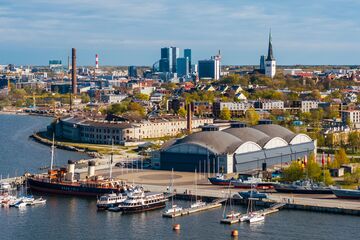
Hell on the Baltic Sea
The aim of the museum lesson is to introduce the evacuation of Tallinn and the events that preceded and followed it in the midst of World War II. The museum lesson opens up the context of the events of World War II, the events preceding the Juminda mine battle and the alternation of occupations. The story of the museum lesson is built on the memories of people who participated in the Juminda mine battle. The work of cultural figures who evacuated to the Soviet Union during the occupations is also discussed, supporting knowledge of art, literature and music history.
The hard choices of the boat escapees of 1944
During the program, the journey of five II MS refugees from their home beach to the refugee camp will be experienced. Together, they look for a carrier and apply for refugee status in Sweden or Germany. Everyone has to tap their conscience and, if necessary, slip a little to pass the screening and get permission to stay in the camp. Because repatriation can be fatal...
A story within a story: life on a submarine
The aim of the museum lesson is to introduce the story of the submarine Lembit, the development of submarines and life on a submarine. We will take a time trip to the end of the 1930s, when the adventures of the submarine Lembit are intertwined with a pivotal period for the Estonian state. We will discuss the impact of science and technology on human activity. We will study the history of submarine navigation in general, as well as that which is directly related to Estonia. Students will learn about the operations in which Lembit participated, and younger students will focus on life on the most famous Estonian submarine. In grades 1–6, the activities are more playful: students learn about the history of Lembit and the events that took place in Estonia at the same time through a game. With students in grades 7–12, we will also discuss in more depth the topics of national defense in history and today: the important events of the creation, formation, loss and restoration of the Estonian state through the story of Lembit.
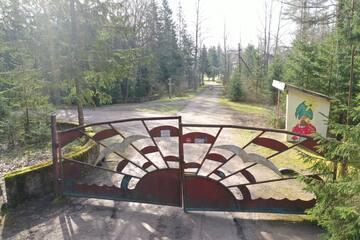
Tour of the former military town
Near Lake Platelia, in the forests of Ploštinė in 1960. the construction of the underground base for launching thermonuclear missiles "Dvina" was started. in 1962 at the end of December, the first combat alert was announced at the base. In four 30-year-olds 4 R-12U type medium-range ballistic missiles armed with thermonuclear warheads are deployed in deep shafts. They were intended to destroy Western European countries.
The top secret facility required a large amount of military equipment and service and command personnel. For that purpose, a town with 30 buildings was established 500 m from the missile launch site. The entire facility occupied an area of about 12 hectares, surrounded by as many as 6 protective fences.
What happened here, what was the purpose of the buildings and what fate befell the military town and what secrets Ploštinė forest still keeps, you will find out on the excursion...
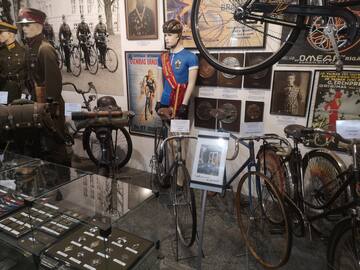
Excursion to the Saulkrasti Bicycle Museum
The largest collection of bicycles in the Baltics can be seen in the museum. In total, the museum houses about 60 bicycles made and used in Latvia, including army model bicycles. The bicycle museum in Saulkrasti attracts visitors with its ancient atmosphere and interesting collection. The bicycle collection of father and son Jānis and Guntas Seregins has become a unique witness of history. One of the first high-speed bicycles, a bicycle with the first inflatable tires and even a wooden bicycle can be seen in the museum. The collection has a wide range of things related to the use of two wheels, the sport of cycling, associations and the manufacture of bicycles. In addition, the collection is constantly updated. Guided visit to the museum with an engaging narration.

Excursion through the "Muitas nams" repository of cultural history and local history materials of Ezere
During the excursion, visitors have the opportunity to see a modern and interactive exposition "End of hostilities in Kurzeme" about the end of hostilities in Latvia and the signing of the act of surrender of the army group Kurzeme in Ezere. It also emphasizes the consequences of warfare today, where the evidence of World War II is not only history, but also everyday reality. The exposition is multi-layered and intended for both students and those interested. Also, with foreign visitors in mind, the content is also available in English. To appeal to history enthusiasts, in the in-depth part of the exhibition content, there is an opportunity to find specific, detailed information about the army units of the warring parties in Kurzeme at the end of the Second World War. In the storage, you can also learn about the history of Ezere Parish, personalities and events in different time periods.
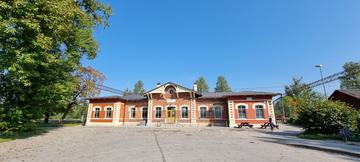
Museum classes on the War of Independence
Stories with pictures and museum exhibits. Possibility to give tasks to the students. Choice between three topics: 1) The decisive battles of the War of Independence 3.–6. January 1919; 2) Armored trains in the War of Independence; 3) Jaan Lepp - hero of the War of Independence and sportsman from Anija municipality.
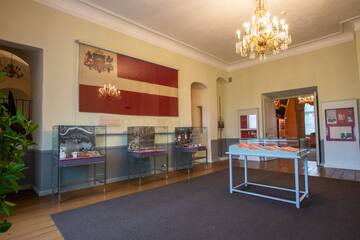
Deficit and Blatt
The lesson is based on the traveling exhibition "Deficit and Blats". The students' task is to compare, summarize and explain the information to their peers using various sources. Work with key words: deficit, blat, perestroika, stagnation. Opportunity to participate in the "Valuables and Property Lottery" prize draw. Won scarce goods and help from the teacher. In order to consolidate knowledge and 100% believe that the deficit and blat really worked, the students have homework - interviewing their relatives who experienced this time and writing down their memories. The topic of the lesson is related to the topics of the subject "History of Latvia and the world". 9th class "Soviet occupation and its consequences" and 12th class. "Latvia in the USSR. The influence of the Soviet era on Latvian society, economy and culture". The author of the "Deficit and Blats" exhibition is Anda Opolska, senior expert of the Cēsi Zonal State Archive.
What do you know about Latvia?
The lesson consists of two parts. In the first one, the students familiarize themselves with the museum exposition: "The Red-White-Red Flag in the History of Cēsis and Latvia", "Cēsis and Latvia's Freedom Struggles." This is followed by a practical lesson on the etiquette of the national flag and a quiz with questions on various topics about Latvia. The topic of the lesson is related to the 6th-9th grade of the subject "History of Latvia". class topics.
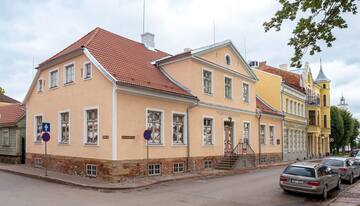
Lecture by museum curator
Curator Jaak Pihlak. 1. The birth of Estonian independence and the War of Independence; 2. Cavaliers of the Estonian Freedom Cross; 3. History of Viljandi Museum; 4. Heritage protection movement in Viljandimaa; 5. Bear-killing Estonians.
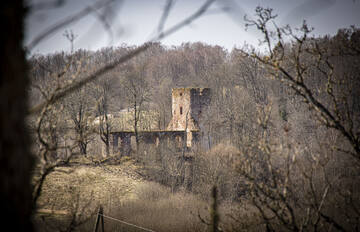
Expedition in the ancient valley of Embūte
the opportunity to get to know the ancient cultural history of Embūte. Visiting Embūtes TIC expositions, Knights' Hill, Indus and Arias Oak, Church Ruins, Curonian Sword, Lookout Tower, Yoda Dam, Indus and Arya Sculptures, Yoda's Footstone, Pilskalns Spring, Curonian Mounds in a guided expedition.
"In the footsteps of Yoda." – 3.5 km long circular trail.
"In the footsteps of Indul and Arija" - a 5 km long circular trail.
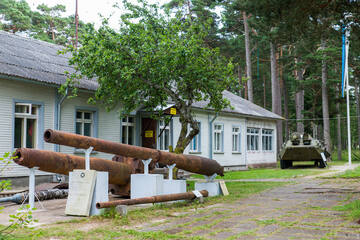
Guided tour in Hiiumaa Military Museum
The tour introduces the museum's exposition: Hiiumaa's coastal defense facilities, weapons and ammunition. Each exhibit has its own story: where and when it was found, who found it and what interesting things have been said about it. The era of the Soviet border guard in Hiiumaa cannot be overstated or ignored: we will introduce the barracks environment, surveillance and communication equipment, and we will set up a reconstruction of the border strip in the yard. The "military design" of the Soviet Army has helped us effectively, collections can even show how clothes racks were made from nothing and how barracks furniture was designed.
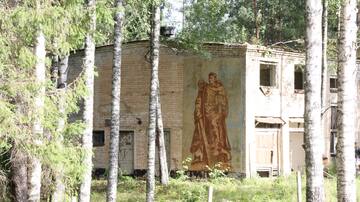
Excursion to the nuclear missile base in Zeltinių
When you visit this top-secret military facility, during a two-hour guided adventure, you will find out where the nuclear warheads were assembled and how they were transported, what components are needed for a complete missile launch, during the creative activities "Tuthead", "Radist's letter", "Save what you can" and a tour at the nuclear missile base. for assembly and whether missiles have ever been launched from this base. You will stay in the Communications hangar and decipher a secret message, visit several bomb shelters and find out where the missile launch button was.
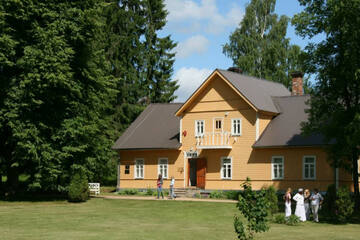
Border and cultural tour
Keywords: national border vs control line, Saatse Boot, the tasks of the border guards, formation of Setomaa's borders, Saatse nulk, Setomaa nature and culture
Role play
Saatse Museum is able to offer you an engaging role play thanks to its location near the temporary control line. During the role play, the participants can put themselves in the role of border guards and smugglers and solve various tasks, the main topics of which are: national border, border guards, illegal trade and also identity documents through the ages. During the role play, participants can find checkpoints on the terrain in a predetermined order using a map, where they have to solve tasks according to their roles. In addition to smugglers and border guards, each team includes one member with an additional task, a "nature-conscious environmentalist", whose task is to search for answers to additional nature/environmental thematic questions together with the team.

Museum pedagogical lesson "General Valdis Matīss"
In the lesson, students will get to know a prominent figure in Latvian military history - Valdis Matīs. They will view an exhibition dedicated to him with uniforms, awards and photographs. They will complete various tasks that promote understanding of history.
Excursion "Latgalian Partisan Regiment"
In the Balvi Regional Museum, in the exhibition "Northern Latgale for the Independence of Latvia", you can learn about the history of the Latgale Partisan Regiment. Then, you can take a walk around Balvi, visiting places related to the Latgale Partisans - the monument dedicated to the Latgale Partisans and the place where the regiment's headquarters was once located.

Class exchursion
The KGB Cell Museum offers tours for all ages. During the hour, we will give an overview of the gray house, where in the 1940s-1950s NKVD/KGB operated in the 1990s, and the exposition, which deals with World War II, Estonia's post-war freedom struggle, the crimes of the communist regime, and the living conditions in the pre-trial prison.
Propaganda
Propaganda"
The museum lesson gives students knowledge about the definition and history of the formation of propaganda and presents more striking examples. A short tour at the beginning of the class introduces the museum's exposition. Then we engage the students in a seminar-style discussion to demonstrate, using propaganda as an example, how despite the passage of time, some things in politics and warfare hardly change at all - only the means and goals are slightly different. In class, together with the students, we observe and analyze propaganda posters, we look for the most common symbols, the use of national stereotypes, etc.
The student who participated in the museum lesson knows the concept of propaganda and stereotypes, can describe the goals and effects of their creation. Knows what type of propaganda has been made in Estonia. Can make connections between the past and the present. The lesson develops the skill of discussion and self-expression
Tartu during WW2
The museum lesson introduces the students to the fate of our hometown in the Second World War. A short tour at the beginning of the class introduces the museum's exposition. Then the student will gain knowledge of 1941‒1944 based on a lot of picture material, wartime periodicals and memories of contemporaries. of the war events in Tartu. The slide program demonstrates the consequences of battles and war crimes and what Tartu was like during the war and what it looks like now. The student who participated in the museum lesson knows the history of Tartu during the Second World War. Knows what life was like during the war and how the war affected people, and can make connections between Tartu at that time and today. Knows the concept of a war crime
Deportation
The museum lesson gives students knowledge about mass deportations committed in Estonia in 1941 and 1949. At the beginning of the lesson, the students will be part of a slide program that introduces the nature of deportation, the organizational details of the mass anti-humanity operations in Estonia, the target groups, and the specifics of the execution. During the program, students are involved in presenting their understandings and taking positions. After the slide program, there will be an excursion that introduces the museum's permanent exhibition. The student who participated in the museum lesson knows the concept, purpose and impact of deportation. Knows why and how deportations took place in Estonia, from the compilation of lists to its far-reaching social and economic effects. The lesson develops discussion skills.
Armed resistance – forest brothers in Estonia
The museum lesson provides students with knowledge of the various stages of armed resistance in Estonian history. The main focus is on the post-war armed resistance, but the so-called Summer War period of 1941 is also discussed. The museum lesson uses revealing information visuals as well as short clips that describe the survival and resistance strategies of the Forest Brothers.
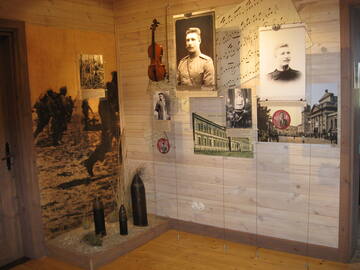
From country boy to national hero
During the lesson, students learn about Oskar Kalpak's life path in the form of an orientation game and perform tasks in teams in the open air around the museum.
Civic Education and Historical Understanding Center at the Colonel Oskars Kalpaks Museum
The concept of the Civic Education and Historical Understanding Center is based on the three dreams of Artūrs Galindoms, a traveler, former participant in the War of Independence, architect and designer of the "Airītes" museum building - The Fight for Latvia; The Memory of Heroes; The Building of the State and Pride in Latvia. These dreams have been re-materialized in the interactive content of the Civic Education and Historical Understanding Center of the O. Kalpaks Museum.
The nature and interactivity of the History Understanding Center introduces the cultural history, architecture, material culture, and social life of our country. It offers a unique and informative multi-layered environment that embodies the spirit of childhood discovery and where you can learn about our country's history through more than 70 different activities.
Day of young guards at the museum
During the lesson, students gain knowledge about the battles of the 1st Latvian separate battalion in Kurzeme and the events in the territory of the O. Kalpak museum during World War II, as well as work in teams in the open air, performing practical tasks.
Journey to 1919
During the lesson, students learn about Oskar Kalpak's life path, feel the situation of the soldiers of Kalpak's battalion at the beginning of 1919, perform tasks in teams or companies related to the beginning of the formation of the Latvian army.

Military heritage in Alūksne county museum
The Alūksne New Palace, which was once the home of the 7th Sigulda Infantry Regiment, now houses the Alūksne County Museum, where students learn about the history of Alūksne and the importance of the army in its growth in the "Memorial Room of Victims of the Totalitarian Regime" expositions, which tells about the fate of the residents of Alūksne County in Siberia and the Far East , but in the exposition of the history of Alūksne "Feast of the Ages" it will be interesting to learn how time periods from prehistory to the present meet. A separate chapter is dedicated to the contribution of the 7th Sigulda Infantry Regiment in the military, cultural and social life.
Theatrical-educational performance with participation "Five fate stories"
The program promotes students' understanding of the course of deportations carried out by the Soviet authorities, the life of Latvians in exile, emphasizing the preservation of national identity and the consequences of deportations in the development of Latvian history and culture. During the lesson, students will be involved in learning the fate stories of five different characters who experienced deportation events. The stories of the fate of the deported children will be acted out by the museum staff, involving students in the lesson. Under the strict supervision of the Red Army, the participants will have to find the missing fragments in the diaries of the repressed, orient themselves in the sentence written in Russian, find an encrypted text, read it in mirror script, analyze the photo material and look for answers to unclear questions. The tragedy of the time of deportations will be accentuated by the uncomfortable working conditions, the unavailability of materials, contradictory, unconditional demands, the non-compliance of which was punished during the deportations. During the program, students learn to see, discover and analyze causal relationships in historical processes and use them to explain social processes. Finds out the changes that took place during the deportations and concludes how they are related to the political situation in Latvia and the world. Analyzes factors affecting change. Learns to cooperate with peers, to use various material sources. During the program, students learn to recognize and offer solutions in situations where people's physical and emotional safety are threatened, to discuss the moral and ethical aspects of the value of life. Skills are learned to demonstrate behavior that expresses respect and personal responsibility for the safety and well-being of oneself and others in ambiguous situations. The duration of the program is 60 min. It can also take place during trips to schools.













